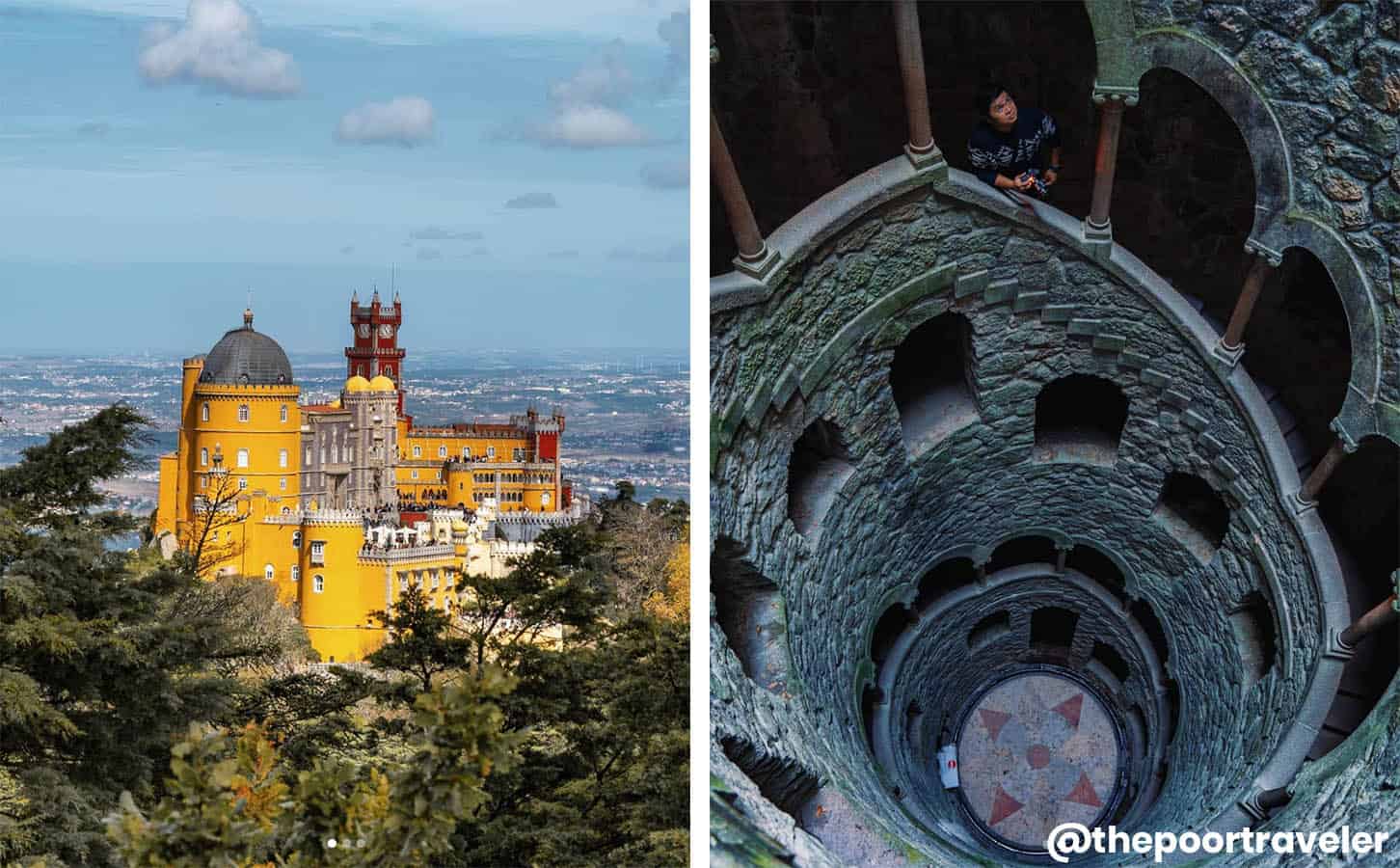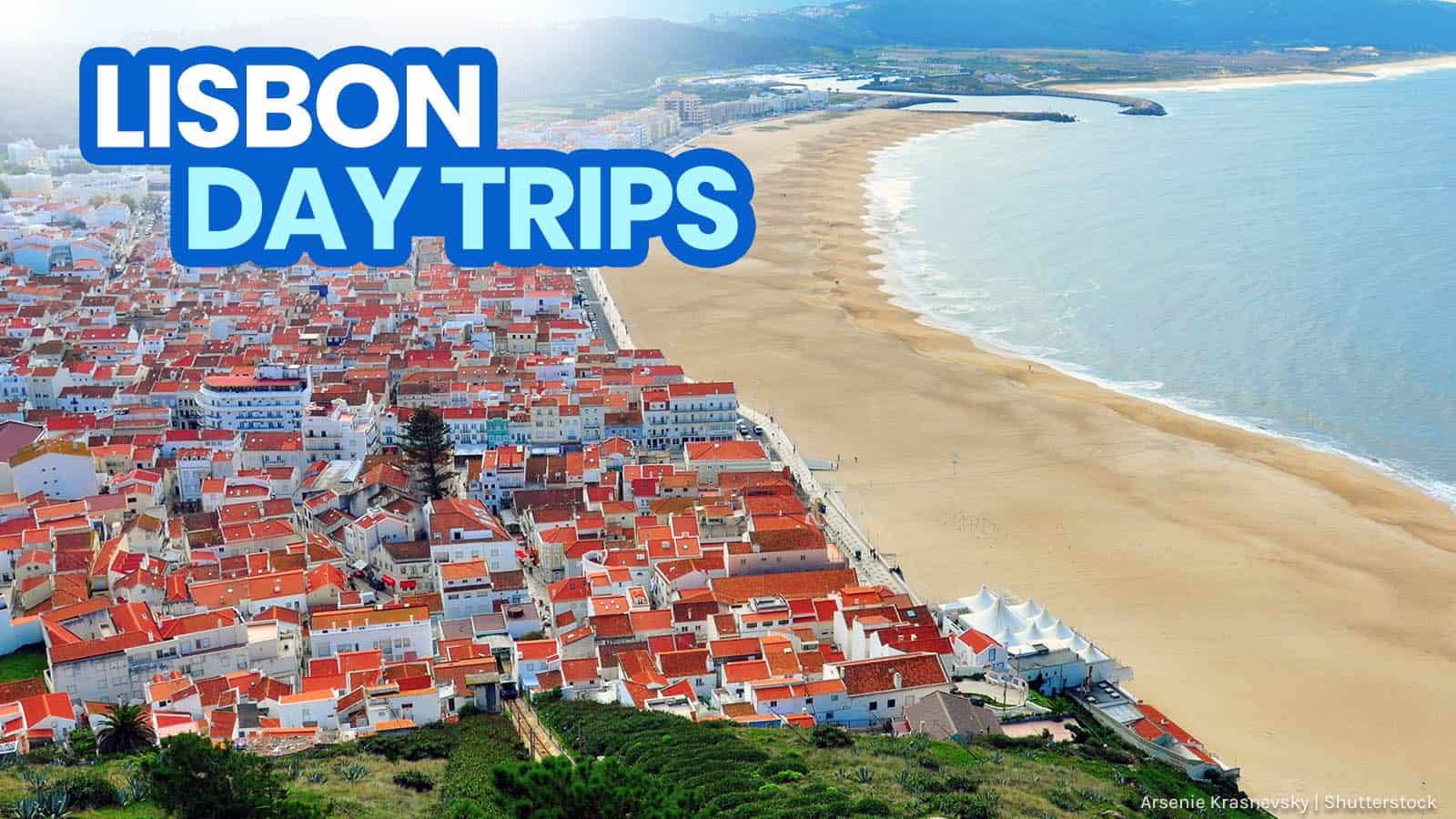As a global city and the capital of Portugal, Lisbon is widely connected by air, land, and sea. The transportation system is efficient and the options are plenty — tram, buses, metro, trains, funiculars, and ferries — making Lisbon an excellent base if you plan to travel not just within the city but also to other parts of the country.
If you are making Lisbon your jump-off point to other nearby attractions, here are some of the places that you can visit on a day trip. In this article, we’re including tours available and links to them, just in case you are thinking of purchasing tickets online or joining a guided tour.
1. Sintra
Located west of Lisbon, Sintra is a famous holiday and weekend getaway place among locals and a day trip destination among tourists. The town is renowned for its historic center, Vila de Sintra, which is also recognized by UNESCO as a World Heritage Site. It boasts medieval palaces, castles, and villas.

Located at the foot of the Sintra Mountains, its landscape is characterized by lush greenery. Consequently, its terrain is adorned with gardens and nature parks. It is also home to high-end dining places and resorts, contributing to its economy and making it one of the richest municipalities in the country.
Popular Attractions: Vila de Sintra, Pena National Palace, Sintra National Palace, Castle of the Moors, and Sintra-Cascais Nature Park
How to Get to Sintra: From Rossio Station in Baixa District, take the direct train route to Sintra Station. The travel time is about 40 minutes.
If you want to join a guided tour that includes not only Sintra but also Cascais and Estoril, you can join a group tour offered below. This covers the entrance tickets, transportation, and a guide.
2. Cascais
Located west of Lisbon and south of Sintra, Cascais is a trendy luxury resort town facing the Atlantic Ocean. It features numerous sandy beaches and surfing spots.
Cascais has been a favored holiday destination of the rich and famous since the 1870s when Portugal’s royal family established its summer residence there. Eventually, this led to other noble families building their summer houses in the area.
Some famous personalities who have lived here were King Luis 1 of Portugal, King Edward VIII of the United Kingdom, King Umberto II of Italy, and King Juan Carlos I of Spain. The neighborhoods symbolize affluence and indulgence, making it a choice venue for events such as international tennis tournaments, golf events, sailing events, and racing, among others.
Popular Attractions: Nossa Senhora da Luz Fort, Citadel Palace, Nossa Senhora da Assunção Church, Paula Rego House of Stories, and Guincho Beach (one of the 17 beaches).
How to Get to Cascais: From Cais do Sodré Station in Lisbon, take a direct train route to Cascais Station. The travel time is about 40 minutes.
Cascais is often bundled with Sintra and Estoril in tour packages.
3. Estoril
Also located south of Sintra and west of Lisbon, Estoril completes the “holy trinity” of luxury resorts in the region, if not the whole country. Estoril is famed for its opulent entertainment facilities and establishments — resorts, restaurants, beaches, and gaming facilities.
Joining its sister luxury resort towns (Sintra and Cascais) in the list of the wealthiest municipalities in the country, Estoril welcomes over a million visitors annually. It is also home to a great number of expats in Portugal.
Popular Attractions: Parque do Estoril, and Praia de Tamariz
How to Get to Estoril: From Cais do Sodré Station in Lisbon, take a direct train route to either Estoril Station (near Casino Estoril) or Monte Estoril. The travel time is about 40 minutes.
✅ GET MORE INFO ABOUT THIS TOUR!
4. Cabo da Roca (Roca Cape)
Cabo da Roca is located west of Lisbon and southwest of Sintra within the Sintra-Cascais Natural Park. The cape is marked by a combination of sandy beaches, barren lands, and rocky cliffs. It also provides a fetching view of the Atlantic Ocean and the rugged western coastline.
The only manmade landmark is the Cabo da Roca Lighthouse, which houses the tourism office. You will also spot a monument that marks the westernmost point of the European continent. Admission is free.
How to Get to Cabo da Roca: From Rossio Station in Baixa District, take the direct train route to Sintra Station. From the station, take the Bus 403 that will make a stop at Cabo da Roca. The total travel time is about one and a half hours.
If you want to combine this stop with a trip to Sintra, Cascais, and Estoril, you can join a group tour like the one below. This is perfect for those who will be coming from Lisbon. This covers the entrance tickets, transportation, and a guide.
5. Fatima
Fatima is situated several kilometers in the Central Region, northeast of Lisbon. The city is well-known for the apparitions of Our Lady of Fatima (Mary) at Cova da Iria in 1917.
Later on, a chapel and a statue were built at the site of the apparition. The Sanctuary of Our Lady of Fátima currently houses them. This religious complex is also home to two minor basilicas and other Catholic religious buildings.
Popular Attractions: Sanctuary of Fátima, Capelinha das Aparições, Basilica of the Most Holy Trinity, Basilica of Our Lady of the Rosary of Fatima, and the Museu de Arte Sacra e Etnologia
How to Get to Fatima: From Lisbon, the direct route is offered by buses departing from Sete Rios Bus Station to Fatima/Cova da Iria Station, which is close to the sanctuary. The travel time is one and a half hours. If you will take the train, you have to make a stop at Caxarias Station and ride a bus to Fatima from there. The travel time is about three hours for the train-bus combination route.
Fátima, Batalha, Obidos and Nazaré are usually packaged together in one itinerary.
6. Batalha
Bathala is situated in the Central region, west of Fatima and several kilometers north of Lisbon. Just like Fatima, this is included in the itinerary of those who are on a pilgrimage or devotees.
But those who are also interested in architecture marvel at the Gothic and Manueline style of the Monastery of Batalha, officially named Monastery of Saint Mary of the Victory. The Dominican monastery was built in this unassuming town by King Joao I, keeping his promise to the Virgin Mary before his victory against the Spanish King Juan in the Battle of Aljubarrota in 1385. The construction started in the 14th century and finished in the 16th century. The monastery also has the royal tombs and the burial place of prominent personalities and unknown soldiers.
Popular Attractions: Monastery of Santa Maria da Vitória na Batalha, Statue of D. Nuno Álvares Pereira, Ponte da Boutaca, and Igreja Matriz de Exaltação de Santa Cruz
How to Get to Batalha: From Lisbon, the direct route is offered by buses departing from Sete Rios Bus Station to Bathala. The travel time is about two hours.
Batalha, Obidos, Fatima and Nazaré are usually covered in most one-day tour itineraries.
7. Nazare
Nazare is located on the western coast of the Oeste region, northwest of Lisbon. The municipality is known for its long sandy beaches and towering waves, making it the venue for international surfing competitions. In fact, one of the highest breaking waves was recorded in Nazare, resulting in professional surfers setting and breaking world records here.
In September, throngs of tourists (mostly pilgrims and devotees) travel to Nazare to witness and participate in the celebration of the Feast of Our Lady of Nazare.
Popular Attractions: Nazare Beach, Fort of São Miguel Arcanjo, Nazare Lighthouse, Forno de Orca Cave, Praia Nova, Miradouro do Suberco, and Museu Dr. Joaquim Manso
How to Get to Nazare: From Lisbon, the direct route is offered by buses departing from Sete Rios Bus Station to Nazare Bus Terminal. The travel time is about two hours.
Nazare, Batalha, Obidos and Fatima are typically marketed together, part of the same itinerary due to their proximity to one another.
8. Obidos
Obidos is situated about 80 kilometers north of Lisbon. The walled medieval town is perched on a hill features well-preserved ancient structures, narrow cobbled streets, and the 9th-century Obidos Castle, which hosts a pousada — a type of hotel installed in historic buildings.
The castle holds a “Medieval Market” event in July for two weeks, recreating how things were during the Middle Ages.
Popular Attractions: Obidos Castle, Obidos Walls, Aqueduto de Óbidos, Porta da Vila, and Ginjinha d’Obidos drink
How to Get to Obidos: From Lisbon, the direct route is offered by express buses (Rapida Verde) departing from Campo Grande Bus Station to Obidos’ Rua da Praça bus stop. The travel time is about an hour. Note that the Rapida Verde bus at Campo Grande might flash Caldas da Rainha, which is the last stop of that route.
If you are after convenient point-to-point transfers, you can check the package offered below. This is a day trip from Lisbon to Obidos, Fátima, Batalha, and Nazaré. This covers your roundtrip transfers, a multilingual guide, insurance, and a shot of Ginjinha.
9. Mafra
Mafra is another municipality on the western coast of Portugal. It is located 30 kilometers northwest of Lisbon and is part of the Greater Lisbon subregion.
This quaint town is known for its vast 18th-century palace complex, the Mafra National Palace, which is located near the Tapada Nacional de Mafra, an enclosed wildlife reserve. The extensive complex was commissioned by King Joao V after the birth of his long-awaited heir. It encompasses not only the royal residences but also a monastery, a basilica, and a huge library. The monastery contains staterooms and also served as a hunting pavilion for the nobility during that period. The basilica is situated strategically between the King’s Tower and the Queen’s Tower. The library boasts over 36,000 ancient books and manuscripts. This is a UNESCO World Heritage Site.
The nearby coastal town of Ericeira is a popular surfing destination.
Popular Attractions: Mafra National Palace, Jardim do Cerco, Tapada Nacional de Mafra, and Aldeia Típica de José Franco
How to Get to Mafra: From Lisbon, the direct route is offered by express buses (Bus 209) departing from Campo Grande Bus Station to Mafra (Palácio) bus stop. The travel time is about 45 minutes. Note that the bus at Campo Grande might flash Ericeira, which is the last stop of that route.
If you want to pair Mafra and Obidos in one go, you can travel comfortably and conveniently through this small-group tour, which includes roundtrip transfers, a professional guide, entrance fees, and sampling of cheese and other traditional food. This tour departs from Lisbon.
10. Evora
Evora lies 130 kilometers east of Lisbon. Dotted with numerous historical and cultural monuments, the historic center of Evora is nicknamed by UNESCO as a museum city, gaining its spot in the list of the organization’s World Heritage Site. It’s also included in the list of Most Ancient European Towns Network.
Some of the medieval walls that protected the old town center in the past are still standing up to this day. One of the oldest structures within the historic town is the Roman Temple. Evora’s golden age was during the 15th century when it became the residence of the Portuguese royal family.
The Evora Cathedral is another important landmark, surrounded by 16th- to 18th-century whitewashed houses with azulejos tiles.
Popular Attractions: Roman Temple of Evora, Cathedral of Evora, Chapel of Bones, Igreja de São Francisco, Aqueduto da Água de Prata, Praça do Giraldo, Evora Museum, Evora University, and Palácio de Dom Manuel, among others.
How to Get to Evora: There are direct train routes from Lisbon’s Oriente Station to Evora Station. This is the most convenient mode; however, there are only 3-4 daily schedules for this route. Kindly check the website for the exact departure times. The travel duration is about an hour. If you are taking the bus (Rede Expressos), go to Lisbon’s Sete Rios Bus Station and take the direct bus route to Evora Bus Station. The travel time is about an hour and a half.
11. Porto

Porto is Portugal’s second largest city and one of the busiest in terms of tourism and economy. Like the capital Lisbon, it also gained the status as a global city for its role in trade and commerce through its seaport. It is considered the gateway to northern Portugal.
Declared a UNESCO World Heritage Site, it is one of the oldest European centers with the Ribeira district as its historic core, which is proclaimed a National Monument of Portugal. Sightseeing by boat down the Douro River is one of the popular tourist activities.
If you are spending a night, Porto has a lively nightlife. And oh! By the way, it is also home to the world-famous Port wine, so don’t forget to swig a glass of the liquor when you visit.
Popular Attractions: Ribeira District, Douro River, Port Wine, Porto Cathedral, Church of Cedofeita, Church of Saint Francis, Liberdade Square, Crystal Palace, Palácio da Bolsa, Clérigos Church and Tower, Luis I Bridge, and Avenida dos Aliados, among others.
How to Get to Porto: Porto and Lisbon are efficiently linked by air and by land (train and bus). By train, take the highspeed train (Alfa Pendular) from either Santa Polónia or Oriente station. Travel time is about three hours. By bus, take the express bus (Rede Expressos) from either Sete Rios or Oriente bus station to Porto Bus Terminal. Travel time is three and a half hours. By plane, the travel time is about an hour. Promo fares are offered from time to time. Regular airfare is €30-50.
12. Costa da Caparica
Located on the other side of the Tagus River in the Almada district, Costa da Caparica is a coastal civil parish boasting a 30-kilometer long coastline, facing the Atlantic Ocean.
This is more popular among the local tourists, especially during summer. The long and wide stretch of sandy coastline endowed the area with plenty of beaches; some are good for lounging and swimming, while others cater more to extreme water sports guests like surfers and windsurfers or kitesurfers.
Some beaches lined with bars hosting night parties are swarming with partygoers. This is also a favored camping and hiking destination.
If you are curious or interested in nude beach, Costa da Caparica’s Beach 19 fits this preference. There are also beach bars in the vicinity.
Popular Attractions: Costa da Caparica Town, Fonte da Telha, Lagoa de Albufeir, Paisagem Protegida da Arriba Fóssil da Costa de Caparica, Cabo Espichel, Convento dos Capuchos, and the beaches.
Note: For beachgoers who want a quieter vibe, you can travel further south of the Costa da Caparica coastline.
How to Get to Costa da Caparica: From Lisbon, the direct route is offered by TST buses (Bus 161) departing from Praca do Areeiro bus stops to Costa da Caparica Bus Station. The travel time is about an hour. Note that the TST Bus 161 has no specific departure point, but rather picks up passengers from any stops near Praca do Areeiro. Ensure boarding the correct bus by asking first if the bus is going to make a stop at Costa da Caparica.
The link below will direct you to a package for a small-group day trip to Beach 19 from Lisbon for LGBT travelers. This includes roundtrip transfers, beach towel rental, sun umbrella rental, bottled water, and insurance.
13. Setubal Region
The Setubal Region is located further south of Costa da Caparica. It covers the Setubal Peninsula and most of the Sado River region. The landscape is characterized by lush nature parks and fertile valleys that are conducive to vineyard cultivation.
It is one of the country’s world-famous wine region, boasting internationally acclaimed wines and wineries. Winemaking is a livelihood that developed thousands of years ago, and its popularity as a winemaking region catapulted in the late Middle Ages.
Popular Attractions: Arrábida Natural Park, Azeitão, and Vineyard and Winery Tours. Two of the famous wineries are José Maria da Fonseca and Quinta de Alcube.
How to Get to Setubal: The recommended option to fully appreciate the Setubal wine region is through group tours.
If you want to join a guided tour and visit more than one wineries in the region without worrying about the inland transfers, you can find several of them online! This tour below covers entrances fees, roundtrip transfers, visiting three wine cellars, sampling a total of 10 wines, tasting traditional cheese and bread, and a multilingual guide.
14. Troia Peninsula
Troia is a 20-kilometer longitudinal peninsula sprawled next to the Sado River estuary. The peninsula is characterized by long sandy coast on the western, northern, and eastern sides. These sandy shores are speckled with beaches and resorts that attract tourists — both locals and foreigners.
There are high-end resorts, restaurants, entertainment facilities and golf courses, but there are also public beaches and tourism establishments that cater to budget travelers. The beaches on the western coast face the Atlantic Ocean and are frequented by professional and newbie surfers.
The northern coast, which is near the Troia Marina and Setubal municipality, can get really busy during the summer months. The central area is populated by numerous resorts, while the base of the peninsula is punctuated by Comporta Village, known for its luxury resorts.
Aside from the beaches, tourists also enjoy birdwatching and dolphin-spotting. For history buffs, the eastern portion also nestles the Roman archaeological sites.
Popular Attractions: Praia Troia Mar, Praia Bico das Lulas, Praia Atlantica, Praia da Comporta, Reserva Natural do Estuario do Sado, Cetobriga Roman Ruins, and Carrasqueira Fishing Village
How to Get to Troia: Troia has two ferry ports — Troia Marina (north) and Cais Sul Terminal (east near the peninsula base). From Setubal Marina, you can reach Troia Peninsula by ferry from Setubal Pier 3 for foot passengers and from Setubal’s Doca do Comercio for those bringing their cars or bikes.
15. Sesimbra
Sesimbra is a coastal town located at the foothills of the Serra da Arrábida, which separates the town from the town of Setubal. It is another popular beach and nightlife destination in Portugal.
Aside from the sandy shores, its thriving fishing villages supply the town with the freshest catch every day, attracting tourists to its traditional fish restaurants. Sportfishing and professional fishing are big here. The town is also a jumping-off point to wreck diving spots.
For those who love forest bathing, you can explore the Parque Natural da Arrabida via its various hiking and cycling trails. Castelo de Sesimbra offers a picturesque view of the town, the Atlantic, and the surrounding areas.
Popular Attractions: Beaches (Praia do Ouro), Fish Restaurants, Outdoor Activities, Wreck Diving, and Castelo de Sesimbra
How to Get to Sesimbra: From Lisbon, the direct route is offered by express TST buses (Bus 207 or 260) departing from Praça de Espanha bus station to Sesimbra Bus Station. The travel time is about an hour.
16. Cheleiros & Bucelas
Located north of Lisbon, Cheleiros & Bucelas are two other wine producers in the region. The wine tasting tours offered by travel companies from Lisbon usually pair these two up to form a unique experience that is not too far from the city.
The itinerary usually includes visits to small wineries and wine cellars and sampling rare wines. Discover the “Price of Portuguese Wines” when you stop by Bucela’s Quinta da Murta. Delight in tasting regional wines at Cheleiros’ ManzWines. Learn more about the history of the industry and how it flourished in these areas, and marvel at the quaint villages and vineyards.
Popular Attractions: ManzWines, Quinta da Murta, Ponte Antiga de Cheleiros, and Museum Vinho e da Vinha de Bucelas
How to Get to Cheleiros or Bucelas: The recommended option to fully appreciate the wine tasting experience north of Lisbon is through group tours. If you plan to pull a DIY, the travel time from Lisbon to either Cheleiros or Bucelas is less than an hour. Head to Sintra and take a bus at Portela de Sintra bound for Cheleiros. From Campo Grande, take Bus 331 or 344 to Bucelas.
17. Tomar
Tomar is located in the Ribatejo region in Central Portugal, 140 kilometers northeast of Lisbon. The town boasts a number of historical and cultural sites and monuments. The most prominent is the Convento de Cristo, an extensive monastery complex on a lush hill. This is registered as a UNESCO World Heritage Site, together with the Castelo dos Templários.
Tomar‘s glory days started back in the Middle Ages, during the Crusades, particularly in the 12th century when the Convento de Cristo was commissioned by Gualdim de Pais, the grand master of the Knights Templar during that time.
As the base of the elite religious soldiers, the town flourished and became one of the powerful cities during the Medieval Period, especially in the 15th century when it became the center of Portugal’s expeditions under the leadership of Henry the Navigator.
Popular Attractions: Castle and Convent of the Order of Christ, Praca de Republica, Aqueduct of Pegões, Museu dos Fosforos, Church of Saint John the Baptist, and Church of Santa Maria do Olival, among others
How to Get to Tomar: From Lisbon, take the regional train from either Lisboa-Santa Apolonia Station or Oriente Station to Tomar Station. The travel time is about two hours.
18. Palmela
Located southeast of Lisbon, Palmela is a small town in the hills of the Serra da Arrabida. Its main feature is its ancient hilltop defensive structure and fortress, Castelo de Palmela. The castle presents a scenic view of the hilly landscape, the town below, and the surrounding areas. It also features a pousada (hotel) and a museum.
Palmela is a major jumping-off point to the wineries and vineyards of the nearby wine locales, particularly Azeitão. You can also easily get to Setubal Port and Arrábida National Park from Palmela.
Popular Attractions: Castelo de Palmela, Igreja de Santiago, Praça Duque de Palmela, Câmara Municipal de Palmela, Igreja de São Pedro de Palmela, and Igreja de Santa Maria Ruins
How to Get to Palmela: From Lisbon’s Oriente Bus Station, take the express TST Bus 565 to Palmela. Alternatively, you can take the train from Lisbon’s Sete Rios Station to Palmela Station. The travel time is less than an hour.
19. Aveiro
Located several kilometers north of Lisbon in the Centro region and along the western coast of Portugal, Aveiro features a vast lagoon that separates the town from the Atlantic Ocean.
Throughout history, the lagoon has played a major role in the town’s economy. It used to be a major seaport during the Middle Ages, but the salinity of the waters feeding the town transformed the former key seaport to molico seaweed harvesting town.
At present, salt production is one of the main contributors to the town’s income. The tourism industry also helps the town through its old town center which features canals where barcos moliceiros, previously used for seaweed harvesting, carry tourists for sightseeing. Other attractions are the Art Nouveau and Romanesque buildings.
Popular Attractions: Old Town Center, Barcos Moliceiros Sightseeing Tour, Igreja de Jesus, Art Nouveau Museum, and Aveiro Museum, among others.
How to Get to Aveiro: By train, go to Lisboa – Santa Apolonia Station and board a train bound for Aveiro Station. These trains are infrequent and usually run every two hours. The travel time is more than two hours. By bus, head to Lisbon’s Sete Rios Bus Station and get on a bus (Rede Expressos) bound for Aveiro. The travel duration is more than three hours.
20. Ilhavo
Also located in the Centro region, Ilhavo is famed for its resort villages — Barra and Costa Nova. These areas are popular summer destinations in the region. Other than the beaches, Barra is home to Portugal’s tallest lighthouse, the 19th-century Lighthouse of Praia da Barra, rising at 62 meters from the ground.
Costa Nova’s Palheiros, traditional houses painted with a vibrant and peculiar striped pattern, using white paint as the base alternating with another bright color. Don’t forget to try the signature Bread of Vale de Ílhavo and Sweet Bread (if visiting during the Easter).
Popular Attractions: Barra, Costa Nova, Palheiros, Lighthouse of Praia da Barra, and Museum Maritímo de Ílhavo
How to Get to Ilhavo: From Lisbon, the recommended is to go to Aveiro first, either by bus or by train. From there, get on a bus to Ilhavo. The travel time is about three hours. You can explore both Aveiro and Ilhavo to maximize your time in the region.
Top Budget Hotels & Apartments in Lisbon
If you’re staying in Lisbon and looking for a place to stay, here are some of the top value-for-money options on Agoda, as reviewed by travelers.

- Destino Lisboa Apartments. Check Rates & Availability! ✅
- Urbano FLH Hotels Lisboa. Check Rates & Availability! ✅
- Lisbon Downtown Inn. Check Rates & Availability! ✅
- Lisbon Rentals Chiado. Check Rates & Availability! ✅
- Tempo FLH Hotels Lisboa. Check Rates & Availability! ✅
- 1869 Principe Real. Check Rates & Availability! ✅
Search for more Lisbon Hotels!
*Edited by Asta Alvarez
2020 • 12 • 23























